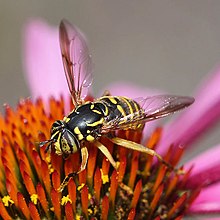Spilomyia citima
| Spilomyia citima | |
|---|---|

| |
| Spilomyia citima | |
| Scientific classification | |
| Domain: | Eukaryota |
| Kingdom: | Animalia |
| Phylum: | Arthropoda |
| Class: | Insecta |
| Order: | Diptera |
| Family: | Syrphidae |
| Subfamily: | Eristalinae |
| Tribe: | Milesiini |
| Subtribe: | Milesiina |
| Genus: | Spilomyia |
| Species: | S. citima |
| Binomial name | |
| Spilomyia citima Vockeroth, 1958[1] | |
| Synonyms | |
| |
Spilomyia citima , the Western Hornet Fly, is a rare species of syrphid fly first officially described by Vockeroth in 1958.[1] Hoverflies get their names from the ability to remain nearly motionless while in flight. The adults are also known as flower flies for they are commonly found around and on flowers, from which they get both energy-giving nectar and protein-rich pollen. The larvae are known as the short-tailed larvae suited for moist areas such as rot holes of trees.[3][4]
Distribution
References
- ^ a b c Vockeroth, J.R. (1958). "Two new Nearctic species of Spilomyia (Diptera: Syrphilidae), with a note on the taxonomic value of wing microtrichia inn the Syrphidae". The Canadian Entomologist. 90: 284–291.
- ^ Nayar, J.L.; Cole, F.R. (1968). "Two new species of Spilomyia Meigen (Syrphidae: Diptera)". The Pan-Pacific Entomologist. 44: 211–214.
- ^ Rotheray, G.E. (1993). "Colour Guide to Hoverfly Larvae (Diptera, Syrphidae) in Britain and Europe" (PDF). Diperists Digest. 9: 155.
- ^ Skevington, J.H.; Locke, M.M.; Young, A.D.; Moran, K.; Crins, W.J.; Marshall, S.A (2019). Field Guide to the Flower Flies of Northeastern North America. Princeton Field Guides (First ed.). Princeton, New Jersey: Princeton University Press. p. 512. ISBN 9780691189406.
Further reading
- Arnett, Ross H. (30 July 2000). American Insects: A Handbook of the Insects of America North of Mexico. CRC Press. ISBN 978-0-8493-0212-1.
